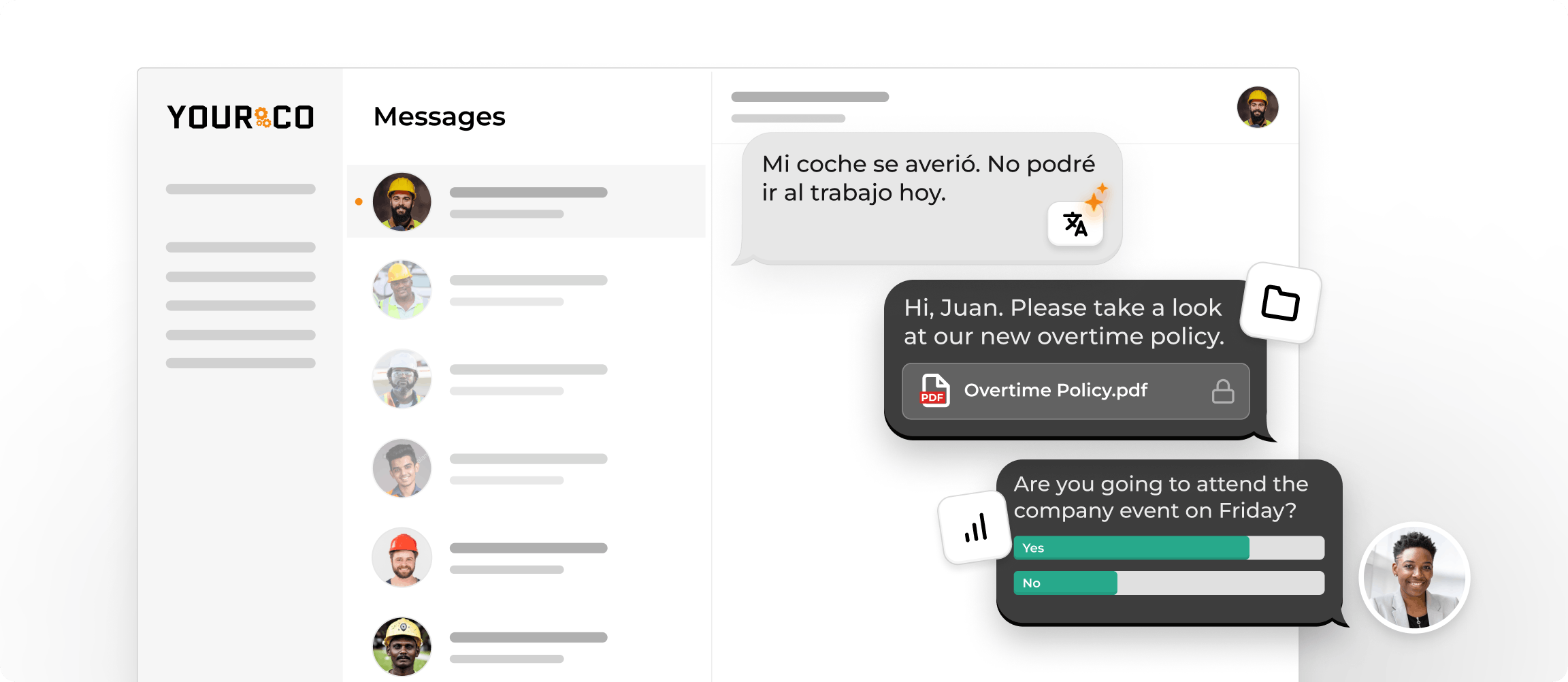Can Employers Send Text Messages to Employees?


Reaching employees quickly is harder than it sounds. Emails are often ignored, phone calls go unanswered, and posted notices reach only a fraction of the workforce. Text messaging solves these challenges by meeting people where they already are: on their phones. It is fast, reliable, and accessible to nearly every employee, whether they work at a desk or out in the field.
In this article, we look at when texting employees makes sense, the best practices to follow, and how organizations can use SMS to strengthen internal communication without adding complexity.
Understand Workplace Text Messaging Guidelines
Many employers find text messaging provides a direct, immediate way to ensure that employees receive crucial information about schedules, operational updates, emergency alerts, and company announcements. Organizations across industries commonly use SMS to bridge communication gaps with their workforce.
Most businesses rely on email as their primary internal communication method, which works well for lengthy messages, spreadsheets, and detailed documentation. However, non-desk employees in manufacturing, construction, warehousing, and agriculture typically don't have company email addresses. Even employees who do have email access may miss critical information due to low open rates and spam filters.
Internal email open rates can be as low as 50%, and spam accounts for nearly half of all email traffic. This creates communication barriers that can impact safety, productivity, and employee engagement. Text messaging bridges these gaps by reaching employees directly on their phones.
An estimated 98% of adults in the United States own a mobile phone. While not all are smartphones, even basic flip phones can send and receive SMS text messages. This universal accessibility makes texting an ideal communication channel for reaching your entire workforce.
Follow Communication Best Practices
When implementing workplace texting, many organizations follow established best practices to ensure effective communication. While we are not legal professionals, these common practices help create a positive experience for both employers and employees. For specific legal interpretation, consult a qualified expert.
Purpose-built platforms like Yourco are designed with compliance considerations in mind, incorporating standard vetting processes and feedback deliverability functionality that many businesses find helpful.
Follow these best practices when implementing workplace texting:
Use a dedicated two-way text platform. Avoid using personal phones to text with employees. Personal devices create privacy issues, complicate record-keeping, and make it difficult to maintain professional boundaries. Yourco provides a secure document access solution that allows you to send mass text messages securely without the chaos of group chats.
Keep texts work-related. Maintain employee engagement by sending only work-related information. Avoid marketing messages or non-essential communications. Text messages should follow the same HR compliance standards as other communication channels. Never send anything via text that you wouldn't say in person, over the phone, or via email.
Set clear expectations. Clarify whether you're sending a reminder or requesting immediate action. Your messages should clearly articulate what you need your employee to do, if anything. Use action-oriented language to eliminate confusion.
Respect work-life boundaries. Emergency communications and schedule changes after hours are acceptable, but avoid sending non-urgent messages outside of working hours. Consider using scheduled messaging to respect your employees' personal time.
Transform Your Communication Strategy with Text Messaging
Text messages excel in specific scenarios where traditional communication methods fall short. Here's how forward-thinking organizations use employee texting:
Deliver Company Announcements Instantly
Keep employees informed about policy changes, leadership updates, and organizational news. From HR messages about open enrollment to operational changes, text messaging ensures your announcements reach everyone quickly. Unlike email, which can sit unread for hours or days, text messages create immediate awareness across your workforce.
Send Critical Employee Alerts
Safety hazards, weather-related closures, and emergency situations require immediate communication. With 95% of text messages read within 3 minutes, you can ensure critical information reaches your employees fast. Whether it's a hazardous condition on-site or a schedule change due to weather, SMS delivers urgent updates when timing matters most.
Streamline Absence Reporting with Text-Off Lines
Traditional call-off systems create bottlenecks and communication gaps. A text-off line provides simplicity and efficiency for employees, HR teams, and managers. Employees can quickly notify supervisors about illness, car problems, or family emergencies without playing phone tag or leaving voicemails.
Boost Survey Participation Rates
Employee surveys help measure company culture, engagement levels, and operational effectiveness. Text-based survey distribution achieves higher participation rates than email campaigns. When you need honest feedback about workplace conditions or engagement initiatives, SMS ensures your surveys actually get seen and completed.
Enhance New Hire Onboarding
Connecting with new hires becomes challenging when they don't have company email access. An SMS-based onboarding platform ensures HR teams and managers can communicate essential information, share training templates, and guide new employees through their first weeks on the job.
Communicate Benefits Clearly
Open enrollment reminders, plan updates, and PTO carryover notices are often overlooked in crowded inboxes. By sending benefits information over SMS, HR teams ensure employees receive timely reminders and easy-to-understand guidance about healthcare plans, retirement options, and other benefits, without requiring them to log in to portals or sift through lengthy documents.
Distribute Employee Referral Opportunities
As companies compete for talent, employee referrals provide access to quality candidates. Text messaging makes it easy to distribute referral links to non-desk employees who might not regularly check email or use professional networking platforms.
Bridge Communication Gaps with Purpose-Built Technology
If you employ workers who don't have company email addresses, you need a reliable method for two-way communication. Traditional solutions like mobile apps create barriers for non-desk workers due to download requirements, data limitations, and password management challenges.
Yourco addresses these challenges by leveraging the simplicity and ubiquity of text messaging. Our platform helps managers, HR teams, and employees communicate effectively without creating additional complexity. Here's why organizations choose Yourco:
Accessibility without barriers. Text messaging works on every mobile phone, from smartphones to basic flip phones. No app downloads, internet requirements, or data plans needed. Your employees can participate immediately without technical hurdles.
Enterprise-grade security. Protect sensitive employee information with data encryption at rest and in transit. Multi-tenant database separation ensures your communications remain secure and compliant with privacy regulations.
AI-powered translations. Connect with employees in their preferred language through automatic translation across 135+ languages and dialects. Ensure critical safety information and policy updates reach every team member, regardless of their primary language.
Comprehensive record-keeping. Maintain searchable logs of all employee communications for audits, compliance, and dispute resolution. Historical records remain available even after employees leave your organization.
HRIS integration. Sync with 240+ HRIS and payroll systems to eliminate manual administrative work. Custom integration filters allow you to control employee access and automate group management based on your organizational structure.
Get Started with Effective Employee Texting Today
Reaching your employees should not be a guessing game. While emails go unread and phone calls are missed, text messaging provides the certainty that your message will be seen. Yourco gives managers and HR teams a reliable way to connect with every worker, from the office to the job site.
Ready to strengthen your communication strategy? Schedule a demo or try for free and see how Yourco keeps your workforce informed, safe, and connected.
Frequently Asked Questions
Do I need employee permission before sending work-related text messages?
Many organizations find that obtaining explicit consent demonstrates respect for employee privacy and helps ensure smooth communication processes. While we are not legal professionals, consulting with qualified experts can help determine the best approach for your specific situation.
Can employees use personal phones to receive work text messages?
Many employees successfully receive work-related text messages on their personal devices. However, using a dedicated business phone number (like Yourco provides) offers several advantages including protecting employee privacy by keeping personal numbers separate from work communications while ensuring all messages are properly documented. This approach helps maintain clear boundaries and professional record-keeping.
What types of work-related messages are appropriate to send via text?
Appropriate text messages include safety alerts, schedule changes, policy updates, training reminders, and brief announcements. Avoid sending lengthy explanations, or non-essential communications that could be perceived as spam.
How can we ensure text messages reach employees during emergencies?
SMS messages are delivered even when internet connectivity is limited, making them ideal for emergency communications. Using a platform like Yourco ensures reliable message delivery, provides confirmation when messages are sent successfully, and maintains logs for compliance and follow-up purposes.




